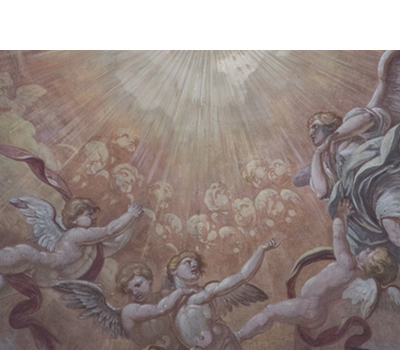
Those who go from the Medina city gate to Pignasecca square, find on the left side a complex of factories located between two streets, one called Nuova dei Pellegrini, the other Vico Pellegrini. In the middle of this complex there is a gate from which is possible to see, in the back, a church.
In the sixteenth century on a piece of land owned by Fabrizio Pignatelli, a very pleasant garden known as bianco mangiare was situated, with the Neapolitan saying that everything nears the delights of the palate, a factory of the Church of the Pilgrims and that of a hospital was built. In 1582 Camillo Duke of Montelelone was given the possibility to donate the hospital and the church to the Arch-Brotherhood of SS. Trinity. A double stair, with two branches for each arm gives access the church through a door that opens between two large stucco statues: S. Gennaro and S. Filippo Neri. The door is adorned with four grooved Corinthian pillars and a triangular front piece with inside the radiant triangle of the Triade, encircled with Angels.
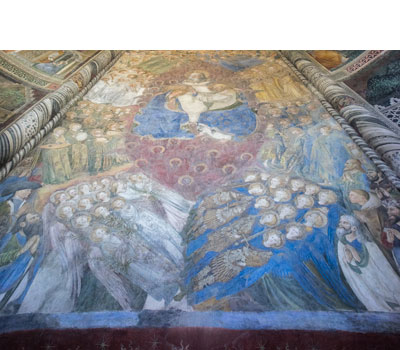
The ancient church built in 1339 was run by the Eremite Friars of Saint Augustine. It is called the road to Carbonara because charcoal was made here during ancient times.
In 1400, the church was renovated by King Ladislaus, where he died and was buried. From under the tomb of the king is it possible to access the Caracciolo del Sole Chapel. Here buried Sergianni Caracciolo, known for the favours he enjoyed with the Court of Giovanna II and his unhappy ending ordered by the Duchess of Sessa, whom had him stabbed. From there you meet the chapel of the Caracciolo Rossi, which exceeds in magnificence all the others in the city of Naples; among the sculptors a competition was born to whom could outdo the others.
In the sacristy are kept eighteen paintings representing stories from the Old Testament with fine marble mosaic ornaments all painted by the immortal Giorgio Vasari.
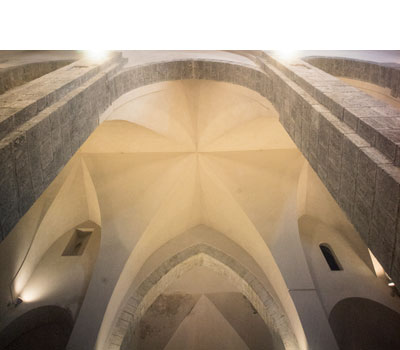
Those whom from the memorable Piazza del Mercato of Naples enter the road that opens to the south-west of it, meet San Giovanni a Mare.
In ancient times, the church was outside the city, where the sea comes close to brushing the walls.
As for whom and when it was built, there is no agreement among the scholars that study such things. It was certainly of Norman era when it was joined to St. John's Hospital, erected by the Knights of the Order of St. John of Jerusalem, that welcomed the crusaders back from the Holy Land.
Norman style arches have survived over time. The three cross vaulted aisles and sharp arches are of the Amalfi school.
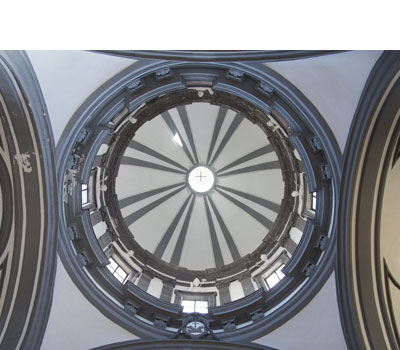
Next to palazzo Cuomo stood an ancient church called S. Maria a Selice, which in the mid-fifteenth century, derelict and almost abandoned, was rebuilt by some devotees in 1448 and dedicated to St. Severo bishop of Naples. In 1575 it was passed to the Dominican Monks who restored it with the design of Giovan Battista Conforto. In this church, on the cross vault to the right of the visitor, it’s possible to observe the beautiful tomb of Gianalfonso Bisvallo, Marquis of Umbriatico whom under Carlo V fought in Tunis.
Meanwhile, the contiguous palazzo Cuomo was abandoned and became so inhospitable that the people believed it was inhabited by sprites and called it the Palace of Monacielli.
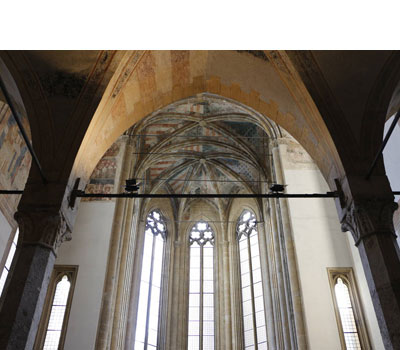
This church and monastery was founded by the first Norman kings and from 1252 here lived the nuns of the Order of St. Benedict. The church was then endowed with rich farms by Queen Mary, wife of Charles II King of Naples, who was buried in this church in a tomb of candid marble.
Towards the end of the sixteenth century, the nuns restored the monastery, enclosing in it the ancient church, which from gothic forms became by clothes and profession a religious Franciscan. The church is both for the paintings and vestments one of the most noble and magnificent of the city of Naples. In the interior of the single naved church, above the main alter, hangs a noteworthy panel painted by Giovan Filippo Criscuolo da Gaeta, a disciple of Salerno. Fine alabaster carvings can be observed in the pedestals of the church aisles. The elegant altar is of ancient green and golden metal. The big chorus above the main altar was decorated with paintings of Solimena.
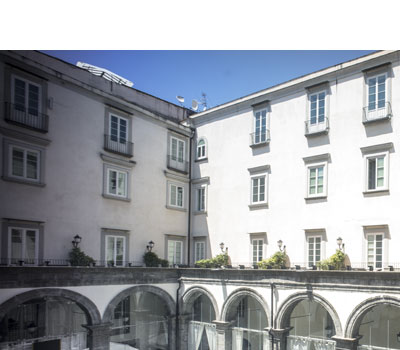
In the Carbonara square there were cruel jousts and tournaments, King Charles II of Angiò raised here a castle in order to watch them better. The castle was then donated by Roberto d'Angiò to Landolfo Caracciolo, as long as he could use it whenever there were jousts and tournaments.
In 1584 Giovan Antonio Caracciolo, prince of Santobuono, bought what remained of the castle and, together with his other houses, formed the magnificent Palazzo Caracciolo Santobuono. The splendor of that complex ended sixty years later, when the peasants made the lords who lived there flee. Enrico Lorena, Duke of Guisa, brought back the building to its passed splendour until the day he had to resign himself to the idea of not becoming sovereign of Naples and abandoned it. The palace housed the Prince of Elbeuf of Lorraine, commander of the Austrian regiment and discoverer of the ruins of Herculaneum and Pompeii.
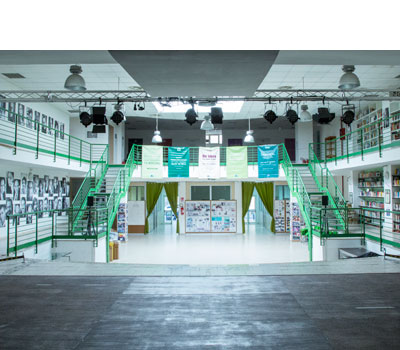
The tangible memory of Annalisa Durante is Piazza Forcella, theater of the people, place of cultural events, where passion for the truth and listening to memories bring together men and their experience in a constant gathering.
The dimension of culture reveals both the fatigue and the beauty of human experience in the continuing search for the truth in order to remind man that is born from beauty and justice e continues in their time.
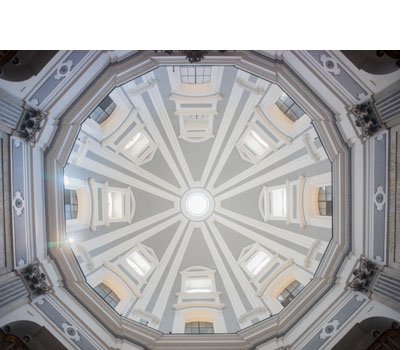
In the year 1602, this pious place was erected by some sacrosanct and charitable Neapolitan gentlemen in order to practice all kinds of mercy.
The Lord Governors dispensed each year many thousands of ducats to the poor and shy people.
In the Chapel, there are many fine painted panels, among which the most prestigious is at the major altar pained by the famous Caravaggio, which expresses mercy as an emotion made of understanding and compassion.
It is also possible to admire the paintings of Jusepe de Ribera, Luca Giordano and Francesco De Mura.
Below the porch in front of the door, on both sides, there are two statues of white marble; one represents Charity and the other Mercy.
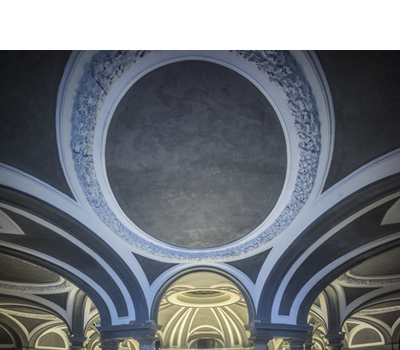
While restoring the Temple of the Annunziata after a fire in 1757, Vanvitelli built a real jewel of his art: the lower church or the succorpo.
The church was blessed on 24 December 1764 in the presence of the Duke of Sorito. Built on a round foundation that corresponds to the dome of the upper church from which, from a circular hole covered by a well-worked brass bridled reticule, light flows in. It has sixteen granite columns of Doric order, arranged two by two in the central area. Between the two pairs of columns, on the wall at the end, there are the two major altars facing each other and, in the middle of these, there are the entrance doors that access the two courtyards of the House.
Both in the floor and the walls, there are the ancient burials to which others were added over time.